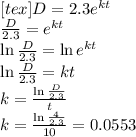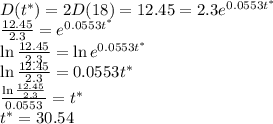
Mathematics, 09.01.2020 20:31 milonirishovnsez
In a study by the texas a & m university, found there were 23,000 prairie dogs in texas in 2000. by 2010, the number has increased to 40,000. the exponential growth function d=2.3e^kt describes the prairie dog population, d in ten thousands, t years after 2000.
a) solve for k
b)by this model how many prairie dogs existed last year?
c)in which year will the population double?

Answers: 2
Another question on Mathematics


Mathematics, 21.06.2019 18:00
Ijust need to see how to do this. so you don’t have to answer all of them just a step by step explanation of one.
Answers: 3

Mathematics, 21.06.2019 20:00
Will possibly give brainliest and a high rating. choose the linear inequality that describes the graph. the gray area represents the shaded region. 4x + y > 4 4x – y ≥ 4 4x + y < 4 4x + y ≥ 4
Answers: 1

Mathematics, 21.06.2019 21:00
Carmen ayer en el mercado compro 3/4 kg de guayabas, 6/8 kg de peras, 1/2 kg de naranjas ¿cuantos kilogramos de fruta compro?
Answers: 2
You know the right answer?
In a study by the texas a & m university, found there were 23,000 prairie dogs in texas in 2000...
Questions

English, 20.09.2019 09:10

Mathematics, 20.09.2019 09:10


History, 20.09.2019 09:10

Mathematics, 20.09.2019 09:10



Spanish, 20.09.2019 09:10

Computers and Technology, 20.09.2019 09:10


Mathematics, 20.09.2019 09:10

Mathematics, 20.09.2019 09:10




Mathematics, 20.09.2019 09:10

History, 20.09.2019 09:10

Mathematics, 20.09.2019 09:10


Biology, 20.09.2019 09:10

 .
. " alt="D=2.3e^{kt}\\\frac{D}{2.3}=e^{kt}\\\ln\frac{D}{2.3}=\ln e^{kt}\\\ln\frac{D}{2.3}=kt\\k=\frac{\ln\frac{D}{2.3}}{t}\\k = \frac{\ln\frac{4}{2.3}}{10}=0.0553" />" />
" alt="D=2.3e^{kt}\\\frac{D}{2.3}=e^{kt}\\\ln\frac{D}{2.3}=\ln e^{kt}\\\ln\frac{D}{2.3}=kt\\k=\frac{\ln\frac{D}{2.3}}{t}\\k = \frac{\ln\frac{4}{2.3}}{10}=0.0553" />" />
 " alt="D(18)=2.3e^{0.0553\cdot 18 }=6.22" />" />
" alt="D(18)=2.3e^{0.0553\cdot 18 }=6.22" />" />


